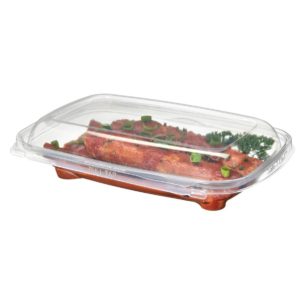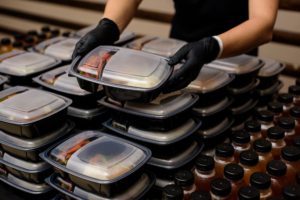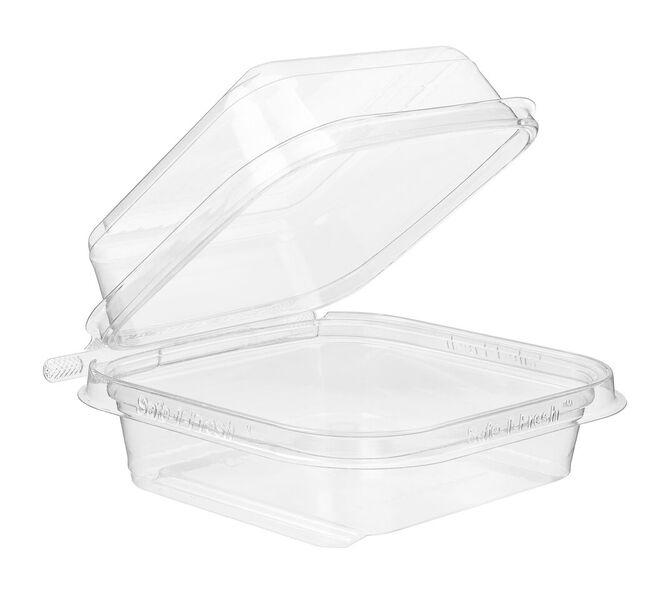If you just opened a new restaurant and need to get your food in the hands of your take-out customers, the packaging you choose can make or break the experience. After all, you don’t want your customers to get soggy food or dipping sauce spilled everywhere! Below, we’ll examine the two most common types of plastic food containers: clamshell and two-piece. By the end, you will have a pretty good idea which is right for you and your business and will be able to close the lid on your concerns.
What Are Clamshell and Two-Piece Packages?
Let’s get down to basics: A clamshell package is a one-piece container with an elbow closure. You’re dealing with a single piece of plastic. It looks like the shell of a clam, hence the name.
In contrast, a two-piece container consists of a base and a lid. You may see these in some deli containers and black or white bottom to-go restaurant containers.
Clamshells vs Two-piece: Best Applications for Each
Along with the noticeable differences in appearance, there are some critical differences between the two products, which will influence your choice for your needs. Below, we’ll explain differences in applications, shipping, and sustainability and cover the advantages and disadvantages of each.
Applications
It’s time to think about your business in particular. You make food that can be taken to go. Many reusable soup containers and takeout packages, such as black-bottom containers, are common two-piece packages.
Black-bottom containers are sometimes used for oily foods to help hide the presence of sauces.
So if you’re looking for a product that hides all those secret ingredients in your special sauces, a two-piece black-bottom may be right.
Shipping
Clamshell packaging is shipped as a one-piece container because it is simply one piece, with the lid connected to the base.
In contrast, two-piece packaging can be shipped in several ways. It can be shipped in “combo packs,” The availability of these combo packs will vary depending on which plastic packaging manufacturer you are using. Most of the time, the products are shipped in two cases: one base and one lid. If your storage space is limited, a clamshell could be the right option for you.
Advantages
Both products have clear advantages. Clamshell containers can offer leak-resistant packaging. Also, since only one plastic product is shipped as a single unit, you have more space in your restaurant. Could this mean more seating? Possibly!
When open, the clamshell takes up more space on a counter. With a two-piece container, you could have multiple bases lined up and ready for food, and you could have an assembly line to pack up your food quickly.
Disadvantages
Let’s call out the elephant in the room: every product has to have a few key drawbacks, and these two are no exception.
We mentioned above that clamshells can take up more surface area when not closed. They also may inhibit an effective food production work line. But things get a little sticky when considering what could go wrong with a two-piece food container.
What if you order a combo pack, and half of the bases are damaged? What if you accidentally receive a shipment of all bases and no lids? You’ll have to get creative with taping two bases together while you wait for the correct shipment to arrive. Or what if you get lids that don’t attach properly to the base? You’ll end up with angry customers demanding you pay their dry cleaning bill.
If you want to avoid these hypothetical problems, a clamshell package may be just the right fit for your business.
But there’s another considerable downside to using a two-piece package: sustainability.
Sustainability
We all want what’s best for the environment. So how do clamshells and two-piece packages stack up?
Clamshell packaging can be recycled when made with clear or transparent materials. The same goes for two-piece containers. The end-user or consumer must take the proper steps to recycle the items.

Not all two-piece containers have a black-bottom base. But if they do, dyes are added to the product during manufacturing, making them generally not recyclable.
According to Green Matters, an eco-conscious news source, plastic sorting facilities can not identify and sort black plastic products because infrared radiation beams are insensitive to black pigments. In short, they are moved to the trash and end up in a landfill.
If sustainability is important for your business, this particular two-piece package may not be a great fit.
So, Which Is Right for You?
When you open the doors to the newest hot spot in town, you should have a pretty good idea of how you’ll pack your food.
There are factors to keep in mind. Which package design works best for you, and what aligns with your business? How much room do you have to store extra boxes of packaging? What is your budget for sustainable products?
Inline Plastics is committed to finding what works best for you, even when that path leads elsewhere. Don’t hesitate to contact us with any questions along the way.


